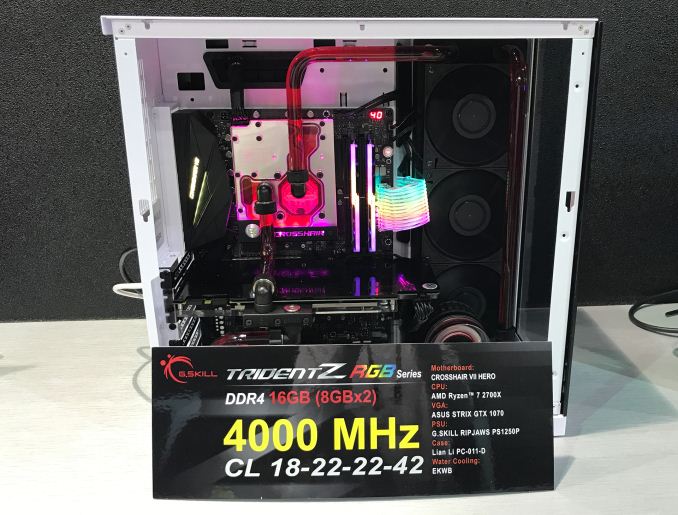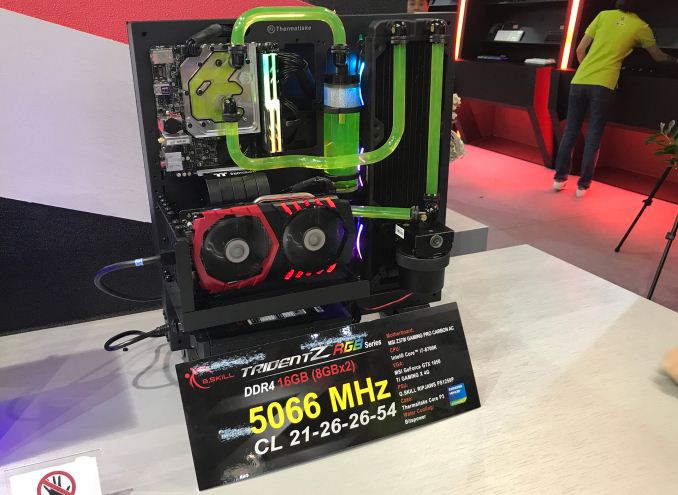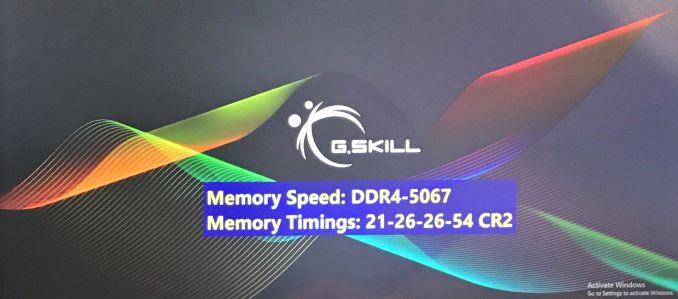G.Skill’s DRAM Extremes: DDR4-4000 on AMD Ryzen, DDR4-5066 on Intel Core i7
by Anton Shilov on June 11, 2018 2:00 PM EST- Posted in
- Memory
- G.Skill
- DDR4
- Trident Z
- Ryzen
- Coffee Lake
- Computex 2018

In the constant race to one-up the other memory vendors in the highly commoditized DRAM market, at Computex last week G.Skill demonstrated its Trident Z RGB memory modules running at rather unprecedented data transfer rates. While operating DDR4 at 5000 MT/s in dual-channel mode is not considered a breakthrough these days, running memory at 4000 MT/s on an AMD Ryzen system is something rather unique.
One of the peculiarities that AMD’s first-gen Ryzen platform has is a memory sub-system that cannot handle data rates significantly higher than 3200 ~ 3466 MT/s. With the second-gen Ryzen platform AMD partially fixed the problem by altering the caching sub-system and upgrading firmware, yet without actually changing the memory controller. Therefore, running memory at high frequencies is still a challenge with the Ryzen 2000-series.
Nonetheless, as the things are getting better, companies like G.Skill can push DDR4 modules all the way to 4000 MT/s with CL18 22-22-42 timings on a Ryzen 7 2700X CPU, as well as with CL20 22-22-44 on a Ryzen 5 2600 processor. Obviously, DDR4 memory modules have to use 1.35 V at high speeds, but G.Skill has not specified voltage for the memory kits in question.
Without any doubts, it has taken G.Skill quite some time to figure out precise sub-timings for a DDR4-4000 operation on a Ryzen 2000-series/X470 platform. Moreover, the company is only demonstrating two dual-channel 16 GB kits, so some luck with the modules and the processors may be involved. Meanwhile, it is also worth mentioning that G.Skill supplies memory for AMD’s Ryzen review kits sent to journalists and other partners of AMD, so it gets to spend more time tweaking SPD settings for AMD Ryzen systems than any other supplier of memory modules.
Intel’s memory controllers and memory sub-systems on the latest platforms have their perks, but G.Skill has a lot of experience with Intel’s CPUs in general. Therefore, it was not surprising to see that the company could hit DDR4-5066 with its latest Trident Z RGB memory modules albeit with very loose CL21 26-26-54 timings at a high voltage.
Obviously, Computex demonstrations do not necessarily indicate imminent product launches. Nonetheless, if G.Skill can hit certain data transfer rates with hand-picked DIMMs, it learns what is needed to replicate the same settings in mass products. The only question is when such products become available and at how high their prices are going to be.
| Want to keep up to date with all of our Computex 2018 Coverage? | ||||||
 Laptops |
 Hardware |
 Chips |
||||
| Follow AnandTech's breaking news here! | ||||||














18 Comments
View All Comments
zodiacfml - Monday, June 11, 2018 - link
We forgot to tell it is overclocked. Oh, the water chiller too.'nar - Tuesday, June 12, 2018 - link
Word games and marketing hype, mostly.DDR4-5066 CL21 is 4.145 nanoseconds
DDR4-4000 CL18 is 4.5 nanoseconds
My RAM is DDR4-3200 CL14 which is 4.375 ns. I always look for lowest latencies, higher speeds are usually over-hyped. It's all about how fast RAM can return data, but the speed in MHz is a measure over one second not per request and to get higher speeds they add wait cycles. 4.5 nanoseconds is how long that RAM takes to provide the requested data, the lower the better. Mine is actually faster per access even though it has a lower MHz speed.
'nar - Tuesday, June 12, 2018 - link
Take the rated speed and divide it by the CL to get your effective speed, that's what you should be comparing. Mine is 228MHz. I think that is 228 MB per second? 1.8GBps after accounting for the 64bit data bus. More due to "double data rate"? QDR now? So 7.2GBps? Let's not forget dual channel memory that pushes it up to 14.4GBps. It's been too long, that's just guessing now.Targon - Tuesday, June 12, 2018 - link
When you talk about memory speeds, you also need to look at the actual impact on performance. When I see high latency memory, the question becomes what the real world performance impact will be. 3200CL14 vs 3466CL15 or 3466CL16, to 3600CL16 to 4000CL20. You would hope that 4000MHz memory would be fast enough to have better performance at the higher latency compared to 3466CL15, but seeing a true benchmark comparison, and on Ryzen where things are far from simple when it comes to high speed memory, it is a good question.SkOrPn - Wednesday, June 13, 2018 - link
I just hope future Zen releases get much better memory controllers. I keep wondering if my Samsung B-die can run faster on a better controller, and if so that might save me some money when/if Zen 3 or 5 comes to AM4. Or what ever the last major Zen version update is for AM4. I'm assuming Zen 3 is the last AM4 chip, but you never truly know until the time comes. If Zen 3 can run 4000 or higher without issues maybe just maybe so can my 3200 b-die, if I'm lucky.Targon - Wednesday, June 13, 2018 - link
If you have memory rated for DDR4-3200, then running it at 3200 won't be a problem. If you buy DDR4-4000 rated memory and you can't run it at that speed due to the memory controller, THAT is a problem. Getting even Hynix M-die to run at 3200 isn't a big problem with relatively recent BIOS versions. 3466 and 3600 will be a bit tougher, but Samsung B-die shouldn't have too many problems with Ryzen.Expecting memory rated for 3200 to run at 3466 if the platform gets a magic update is going to be more a function of the memory itself, rather than the memory controller. In general, you may need to use normal CPU overclocking techniques, such as using more voltage, or using looser timings(go to 16 or even 18 CAS latencies for example).
Oxford Guy - Thursday, June 14, 2018 - link
"at a high voltage"Whatever that means.